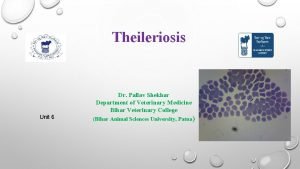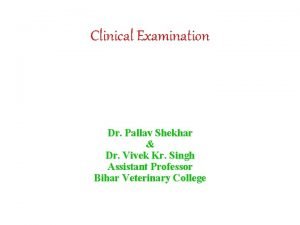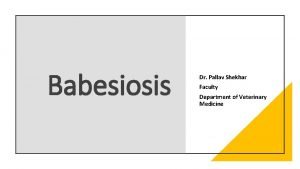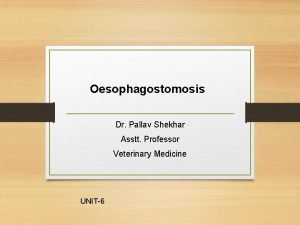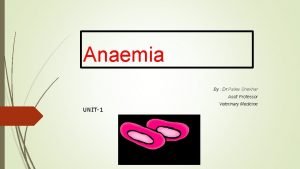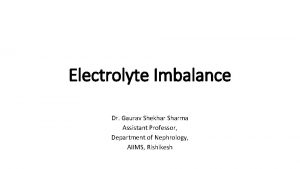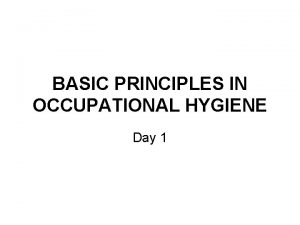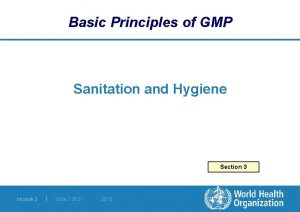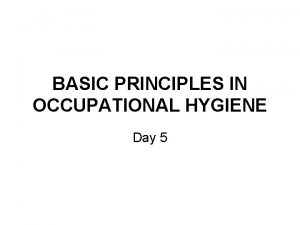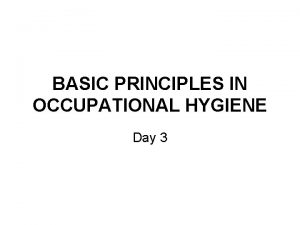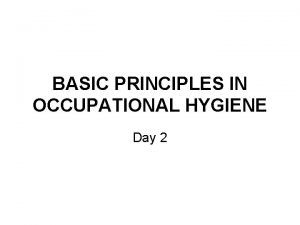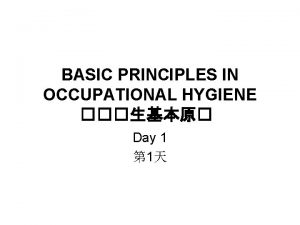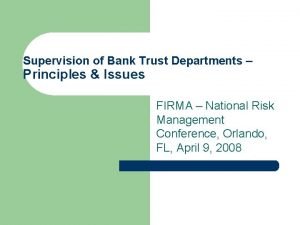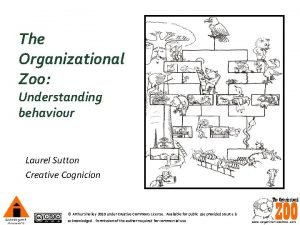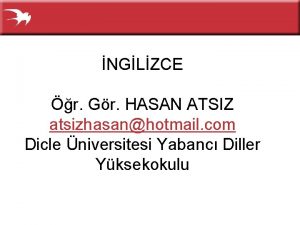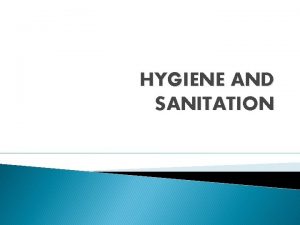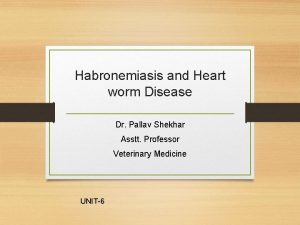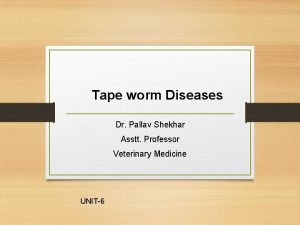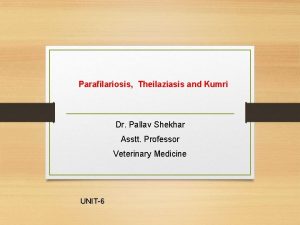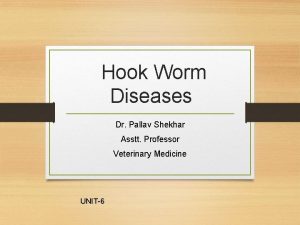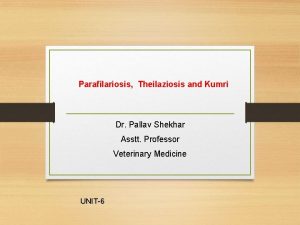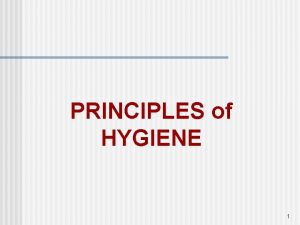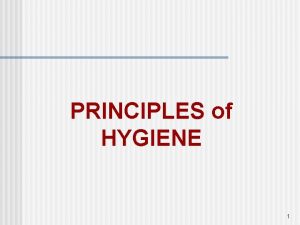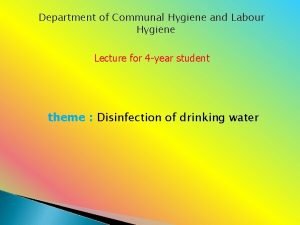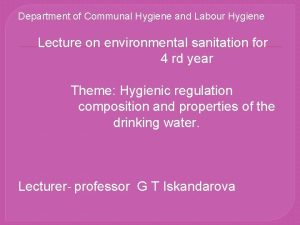Principles of Zoo Hygiene Dr Pallav Shekhar Department



























- Slides: 27

Principles of Zoo Hygiene Dr. Pallav Shekhar Department of Veterinary Medicine Bihar Veterinary College, Bihar Animal Sciences University Unit -4

Introduction • Usage of suitable disinfectant (natural or synthetic) • Proper disposal of carcass • Speedy disposal of feed wastes • Supply of hygienic water • Animal keepers and handlers’ hygiene • Bush clearance (vector control) • Disposal of polythene bags

• White washing of water containers and walls and feeding tanks in a periodical manner. • Adaptation of suitable fly control measures (fly catcher lights) esp. in fed –receiving spots or stores room. • Speedy clearance of sheds / cages after the occurrence of diarrheic stools / after the conducting of operation.


Fly trapping

Protective square of electric fence with Knight Stick sticky trap (1), solar‐powered fence charger (2), and grounding rod (3) contained within

• Strengthening of rodent or pest proof barriers (Vermin control) or cages or fences esp. in aviaries or bird-exhibit places to avoid diseases. • Usage of aseptic infrastructures like sterilized needles, syringes, sample-collecting containers etc. • Laboratory should be a clean one without giving chances for any types of infections

Barrier Design for Zoo


Cage Vs Moated Enclosure


• Usage of aseptic infrastructures like sterilized needles, syringes, samplecollecting containers etc. • Laboratory should be a clean one without giving chances for any types of infections.

Quarantine • The term "quarantine" is a very familiar word in both medi- cal and veterinary science and it was actually derived from an old French official method “querente” meaning forty days of isolation (Arnall & Keymer, 1975) for a ship. • It literally means compulsory isolation or detention to prevent spread of contagion or infection.

Why important in Zoo • Prevention is better than cure” and one of the first steps or practices one would adopt in the realm of preventive medicine is quarantine. • It should be remembered that any newly procured wild animal and bird for a zoo could be a potential source of pathogenic microbes or parasites to an apparently healthy premises and its inhabitants

Quarantine and Its tests Group of Wild Animals Primates Hoof stock Small mammals/ carnivores Birds Reptiles and Amphibians Important criteria to be assessed during arrival of new wild animal species in a zoo as a preventive measure of diseases • Hematology and Serology • Urine analysis • Culture of feces for salmonella /Shigella /Camphylobacter • Serology for Herpes virus simiae (Herpes B) in old world Monkeys. • Chest radiograph • PCR for Tuberculosis • Coprological examination • Hematology and Serology • Coggins test for equid species • Vaccination in endemic areas • Coprological examination • Vaccination applicable • Hematology • Bio chemistry • Urine analysis • Coprological examination • Direct and flotation test • Evaluation for ectoparasites • Fecal culture for salmonella sp • Fecal examination • CBC and blood chemistry • Fecal culture for salmonella sp.

Sanitization and Carcass disposal • Glutaraldehyde shall be chosen for the disinfections processes after the disposal of the carcass, subsequent to the post- mortem. • Anthrax affected carcass or suspected carcass should not be opened and the burial should be carried out at least with two metre depth, with a sample spread-over of quicklime.

Waste Disposal Process • These procedures need to be maintained in a perfect condition in appropriate polythene bags without any spillage in the environment.

• It may be better to burry the carcass, together with the bedding and soil contaminated with discharge. • If spore formation occurs (within few hours of exposure to air), strongdisinfectants may be used like Lysol (this should be in contact with spores for atl east 2 days) or • Strong solution of formalin or sodium hydroxide at the strength of 5 -10%.

• Burning by using a incinerator will be a better practice of disposal of carcass, since it avoids feeding of infected carcass by scavengers like hyena, jackals etc. and also helps to prevent the contamination of the environment in which other wild animals are confined.

Floor sanitation • Despite proper cleaning and one or two times of washing of floor, there are more chances for the accumulation of feces and feces which often get mixed with urine and they get embedded in the crevices of floor or wall. Hence there may be a possibility of a heavy “build-up-of-Potentially Pathogenic Bacteria ”. • Often, due to the conditions like suitable climate that comprises the apt temperature, humidity and rain fall changes, there is increase in the spread and survival of these bacterial organisms especially , when cleaning works are not done in a proper manner. • Application of effective disinfectants like the glutaraldehyde will be of highly useful in destroying the bacterial, viral, fungal and parasitic pathogens.

Vessels • Any stainless steel surfaces (feeding vessels if any) may be cleaned and disinfected with trisodium phosphate. • During adaptation of the sanitation measures in the animal room, it is to be noted that since the alkalis are non-toxic, when adequately diluted they leave no residual odor and are even used in the treatment of floor in food factories and hence can be safely used for floors. • Particularly these materials will be of useful in places where layers of fatty materials may accumulate.

Sanitization • Inside the animal cage / room, the debris need to be cleaned every day. • The high pressure based hose pipe should not be used, because it will lead to the deposition of fomites, aerosol and debris on walls etc. • Always foot bath is to be provided before each wild animal enclosure and the animal keeper should develop the routine habit of dipping his legs in this, before each time of entry in to the animal place.

• Stray dogs, cats, rodents, snails and insects transmit various diseases both in active and passive manners. Hence, a strict control is to be made on the breeding and elimination of them within the zoo premises, to the possible extent. • Moats wet or dry need to be cleaned in a periodical manner and the prompt cleaning measures need to be undertaken with adequate drying of wet moat. • Algae development may be monitored on the wet moats in particular. • Enteric infections may occur when the confined wild animals develop the habit of drinking water. • Bush needs to be cleared with regard to minimizing of incidences with trypanosomes

Cages Documentations are available on the high incidence of enteric infections in cages with has not been cleaned well after the cubbing / farrowing / calving / whelping etc. Unhygienic status maintained within the wild animal cages especially the ones with the new born wild animals lead to infection in the young ones.

Precautions • Precautions should be undertaken with each sanitizing agent that is used in the zoological park, as quoted below: • Smell of the concerned sanitizing agent is one of the important factors to be taken care of in the wild animal enclosures. • The approximate contact time should be maintained for each agent. For example, there is a need of approximately two minutes contact time for the exertion of bactericidal, viricidal and mycobacterial actions of the compounds like iodophors. • It is worthy to mention the iodophors are not suitable as hard – surfaced disinfectant. • It is better to use the Specific disinfectants for the concerned pathogen whether it is a viral or bacterial agent

Specific disinfectants Diseases Specific disinfectant to be used FMD • 4% solution of sodium bi carbonate (washing soda) • Formaldehyde fumigation of materials like straw, grain etc. • Citric acid Anthrax 2 -5% HCl acid to disinfectant the hides and hides contaminated with Anthrax as in taxidermy Rabies Formaldehyde or Cresol may be of usef Tuberculosis 70% Isopropyl alcohol in 5 mtes time or 3% phenol in 2 -3 hrs Herpes virus Gluteraldehyde /Chlorine/Ethanol Fowl pox virus Formaldehyde /Methyl bromide New castle diseases Formaldehyde /Chlorinated lime /Chloramine lime

Staffs • Hands should be washed frequently especially after handling the animal, its food, bedding, enclosure materials, excrement and / or tissue and body fluids. • Cages should be cleaned so as to minimize the risk of creating aerosols or droplets of potentially infectious materials. Wearing protective clothing, especially masks, gloves and glasses or goggles. • The staff should be instructed to engage in proper personnel hygiene procedures in and out of the workplace. • Staff members who are ill with a cold and or having a cold sore should avoid working around the animals. • If staff members get sick they should seek medical attention. • A baseline serum sample should be collected from all personnel working with animals for periodical screening for infectious diseases. • Staff members should take precautions to avoid any physical injury in handling them. • An effective means for handling, reporting, evaluating and treating occupational exposures to possible zoonotic infections should be developed for the institution. • Individuals with a known immuno deficiency diseases should be extremely cautious in working with potentially infected animals or materials. • An active insect and rodent control program should be instituted in the facility. • Personnel who have open cuts or sores on their hands should wear gloves while working around animals and their faeces.
 Dr pallav shekhar
Dr pallav shekhar Dr pallav shekhar
Dr pallav shekhar Dr pallav shekhar
Dr pallav shekhar Dr pallav shekhar
Dr pallav shekhar Dr pallav shekhar
Dr pallav shekhar Dr pallav shekhar
Dr pallav shekhar Dr pallav shekhar
Dr pallav shekhar Hi in hmong
Hi in hmong ايتو
ايتو Gaurav shekhar
Gaurav shekhar Basic principles of occupational hygiene
Basic principles of occupational hygiene Basic principles of personal hygiene
Basic principles of personal hygiene Basic principles of occupational hygiene
Basic principles of occupational hygiene Basic principles of occupational hygiene
Basic principles of occupational hygiene Basic principles of occupational hygiene
Basic principles of occupational hygiene Site:slidetodoc.com
Site:slidetodoc.com Bank trust departments
Bank trust departments Safety rules at zoo
Safety rules at zoo Wiersz jana brzechwy wesołe zoo
Wiersz jana brzechwy wesołe zoo Edible underwater
Edible underwater The professional development group
The professional development group Zoological riddles challenge
Zoological riddles challenge Pep zoo zip
Pep zoo zip Monkey çoğul hali
Monkey çoğul hali National zoo policy
National zoo policy Zoo edward hoch summary
Zoo edward hoch summary Fort wayne zoo prices
Fort wayne zoo prices The learning zoo the woodlands
The learning zoo the woodlands
